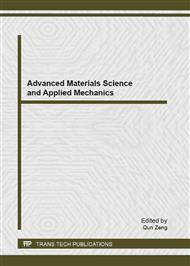p.140
p.145
p.149
p.154
p.159
p.167
p.172
p.176
p.181
Transformation of Pure Al Structure under the Influence of Electromagnetic Field
Abstract:
In paper problem concerning inoculation of primary structure of aluminum with purity of 99,5% and 99,8%, which is realized mainly by intensification of liquid metal movement in mould is presented. In aim of realization of forced movement during the crystallization of liquid metal was used rotating electromagnetic field produced by the induction coil supplied by current with elevated frequency. The degree of structure refinement was represented by equiaxed crystals zone content on transverse section of ingot and average area of macro-grain in this zone. Effect of structure refinement obtained by influence of electromagnetic field was compared with refinement obtained by use of traditional inoculation, which consists in introducing of additives i.e. titanium, boron and carbon to metal bath. The results of studies and their analysis show possibility of effective refinement of pure Al primary structure, only with use of rotating electromagnetic field and without necessity of application of inoculants such a Ti, B and C. This method of inoculation is important, because inoculants decrease the degree of purity and electrical conductivity of pure Al. Moreover Ti and B are reason of point cracks formation during rolling of ingots.
Info:
Periodical:
Pages:
159-164
Citation:
Online since:
May 2013
Authors:
Price:
Сopyright:
© 2013 Trans Tech Publications Ltd. All Rights Reserved
Share:
Citation:


